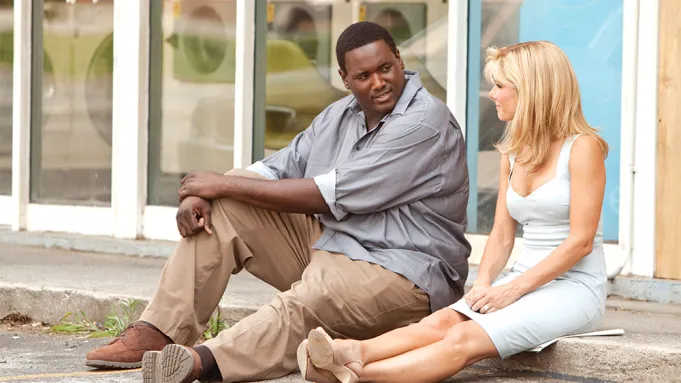In the intricate dance of awards season, the glossy surface of a movie based on a true story can often be scratched, revealing a less palatable reality underneath. We’ve seen it before with films like “A Beautiful Mind,” “Green Book,” and “Mank.” However, occasionally, the criticisms linger beyond the awards buzz. This seems to be the case with “The Blind Side.”
The 2009 drama, which saw Sandra Bullock clinch an Oscar for Best Actress, recently found itself in the midst of a troubling revelation regarding the authenticity of its narrative. The film portrays the heartwarming tale of Michael Oher, a troubled teenager taken in by a well-off Memphis couple, Leigh Anne and Sean Tuohy, who guide him towards a successful career in the NFL. Now, Oher’s legal challenge against the Tuohys alleges that the story depicted in the film was more concocted than genuine.
READ MORE: Ariana DeBose and Chris Messina Team Up for Sci-Fi Thriller ‘I.S. S’ Acquired by Bleecker Street
As the legal proceedings unfold, the idyllic image painted by “The Blind Side” begins to crack. The heartwarming narrative is marred by allegations that Oher was never legally adopted by the Tuohys and that a financial deal was struck for the benefit of the Tuohy family. This legal turmoil undercuts the very foundation of the film, revealing the shallowness of its portrayal.
At the core of “The Blind Side” lies the story of Michael Oher, portrayed on screen by Quinton Aaron. The film introduces him as a docile and gentle giant, taken under the wing of the Tuohy family, played by Sandra Bullock and Tim McGraw. However, the authenticity of this portrayal has been questioned. The legal battle serves as a stark reminder that the relationship between Oher and the Tuohys was more complex and less picturesque than depicted in the movie.
“The Blind Side” paints a rosy picture of Oher’s journey, focusing on the Tuohys’ charitable efforts and selfless commitment to his well-being. Yet, it falls short of delving into the nuances of their relationship, leaving behind the complexities that reality undoubtedly presented. Oher’s allegations highlight the manipulations and misunderstandings that unfolded off-screen, shedding light on a dynamic that the film chose to ignore.
The very essence of the film’s appeal was rooted in its faith-based narrative and feel-good sentiment. It attempted to encapsulate the triumph of human kindness over adversity. However, the current legal battle serves as a sobering reminder that even the most heartwarming stories can carry layers of darkness beneath the surface.
As we revisit “The Blind Side” in light of this controversy, the film’s shortcomings become apparent. The character of Michael Oher is rendered two-dimensional, lacking the complexity and depth that a real individual in his circumstances would possess. The narrative paints him as a passive figure, failing to explore the psychological impact of his experiences and the challenges he faced.
In a world where authenticity and representation matter more than ever, “The Blind Side” now stands as an example of Hollywood’s propensity to simplify and sanitize stories for the sake of entertainment. While the legal battle’s outcome remains uncertain, its impact on the film’s legacy is undeniable.
As moviegoers and critics, we find ourselves questioning the integrity of a narrative that was once celebrated for its inspirational message. It’s a reminder that beneath the glitz and glamour of awards season, the stories we tell on screen are often far removed from the reality they seek to portray. In the case of “The Blind Side,” the gloss has faded, and what’s left is a reminder that even the most heartwarming tales can be fraught with complexities and contradictions.
In the end, the legal battle surrounding “The Blind Side” underscores the importance of digging deeper into the stories we consume, questioning their authenticity, and acknowledging the shades of gray that exist within even the most seemingly black-and-white narratives.
